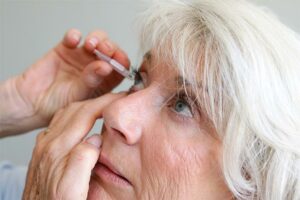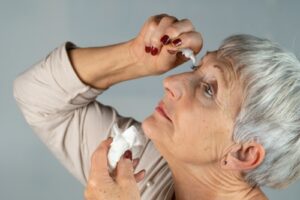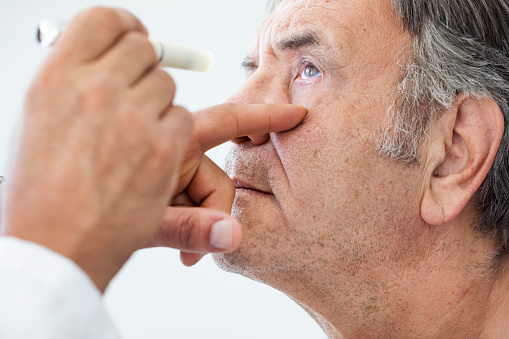Senile cataract is a common eye condition that affects millions of people each year. It is a type of cataract that occurs in older adults, and it is caused by the natural aging process. In this blog post, we will discuss what senile cataract is, its symptoms, and how it is treated. We will also explore some of the risks associated with this condition, and provide tips for preventing it.
What Is Senile Cataract?
 A senile cataract is a type of cataract that typically develops in older adults. Cataracts are a clouding of the eye’s lens, and they can cause vision problems. This type of cataract tends to develop slowly and may not cause noticeable symptoms at first.
A senile cataract is a type of cataract that typically develops in older adults. Cataracts are a clouding of the eye’s lens, and they can cause vision problems. This type of cataract tends to develop slowly and may not cause noticeable symptoms at first.
However, as they progress, they can eventually lead to significant vision loss. Senile cataracts are the most common type of cataract, and they’re also the leading cause of vision loss in older adults. There’s no one definitive cause of senile cataracts, but they’re thought to be related to aging.
According to studies, senile cataract is estimated to affect more than 24 million Americans aged 40 years and older. And around the globe, it can affect over 20% of people aged 60 years and older. The risk of developing this condition increases with age, and it’s more common in women than in men.
Therefore, if you or someone you know is experiencing vision problems, it’s important to see an eye doctor for a comprehensive eye exam. An early diagnosis and treatment can help prevent or slow the progression of senile cataracts and preserve vision.
What Are The Symptoms?
The most common symptom of senile cataract is cloudy or blurred vision. Other symptoms may include:
- Difficulty seeing at night
- Difficulty driving at night
- Increased sensitivity to light and glare
- Halos around lights
- Double vision in one eye
- Fading or yellowing of colors
In many cases, these symptoms can be corrected with glasses, contact lenses, or surgery. However, if left untreated, senile cataracts can lead to vision loss and blindness.
If you think you or a loved one may have a senile cataract, it’s important to see an eye care professional right away for a comprehensive eye exam. Early diagnosis and treatment is the key to preserving vision.
What Are The Causes And Risk Factors?
This type of cataract is most commonly caused by the natural aging process. As we age, the proteins in our lenses start to break down and clump together. This clumping causes the lens to become less transparent and can eventually lead to a cataract. In fact, aging is the most common risk factor for developing a senile cataract.
Other risk factors include:
- Diabetes: This chronic condition can accelerate the aging process and increase your risk of developing a senile cataract.
- Smoking: Tobacco use is another factor that can speed up the lens changes associated with a senile cataract.
- Exposure to UV light: This type of radiation can damage the proteins in your lens, increasing your risk of developing a cataract.
- Family history: If you have a family member with a senile cataract, you may be more likely to develop one as well.
- Certain medications: In some cases, certain medications can cause changes in the lens that increase your risk of developing a cataract. For example, steroids and certain beta blockers have been linked to increased risk.
- Previous eye surgery or injury: Trauma or injury can also cause changes in the lens that make you more susceptible to developing a senile cataract.
These are overall just a few of the many causes and risk factors for senile cataracts. It’s important to keep in mind that this condition is very common and usually not serious. However, if you are experiencing any vision changes, be sure to see your eye doctor for an evaluation.
With early detection and treatment, you can help preserve your vision and keep your eyes healthy as you age.
How Senile Cataract Is Diagnosed?
 A diagnosis is always an essential step in addressing any sort of problem, and the same is true for senile cataracts. However, this particular condition can often be difficult to diagnose simply because its symptoms so closely resemble those of other age-related vision problems, such as presbyopia or macular degeneration.
A diagnosis is always an essential step in addressing any sort of problem, and the same is true for senile cataracts. However, this particular condition can often be difficult to diagnose simply because its symptoms so closely resemble those of other age-related vision problems, such as presbyopia or macular degeneration.
This is why it’s important to have a comprehensive eye exam yearly, especially if you’re over the age of 60. Only an experienced eye doctor can properly diagnose senile cataracts and rule out other possible conditions.
During your exam, your eye doctor will likely shine a light into your eyes to get a better look at the lens. In some cases, they may also use special magnifying glasses to get a closer look. If they suspect you have senile cataracts, they may recommend additional tests, such as an ultrasound or CT scan.
In addition, some common tests to diagnose a senile cataract include:
- Visual acuity test: This measures how well you see at various distances.
- Slit-lamp examination: This allows your doctor to closely examine the structures in the front of your eye, including your eyelids, cornea, iris, and lens.
- Tonometry: This measures the pressure inside your eye.
Once your doctor has diagnosed senile cataracts, they will work with you to develop a treatment plan. This will likely involve a combination of lifestyle changes and surgery. Consult with a professional for a more informed decision!
How To Treat It?
If you are diagnosed with senile cataracts, there are a few things that you can do to help treat the condition. Some of these are listed below:
Surgery
This is the most common and effective treatment for cataracts. It involves removing the cloudy lens and replacing it with a clear artificial one. Cataract Surgery is usually an outpatient procedure, which means you won’t have to stay in the hospital overnight.
The procedure is usually done under local anesthesia, which numbs the area around your eye. You may also be given a sedative to help you relax. The surgery itself only takes a few minutes, but you will need to stay at the hospital for a few hours afterward so that we can monitor your progress.
After the surgery, you will need to wear a protective shield over your eye for a few days. You will also be given eyedrops to help prevent infection and to help your eye heal. You must use these as directed. Most people recover from cataract surgery without any problems.
Medication
Some eye drops can help to improve your vision if you have senile cataracts. However, you will eventually need surgery to remove the cataract. And medications can make cataracts grow faster. So it’s important to talk to your doctor about the risks and benefits of any medications you’re taking.
Lifestyle changes
It is believed that making some lifestyle changes may help to prevent or delay the development of senile cataracts. These include:
- Eating a healthy diet
- Exercising regularly
- Not smoking
- Avoiding alcohol
These things are all important for maintaining good overall health, and they may help to keep your eyes healthy as well. But more research is needed to know for sure if they can help prevent senile cataracts.
Take care of your eyes
 It is always important to take care of your eyes, especially as you get older. One problem that can develop in older age is senile cataracts. This is a clouding of the eye’s lens and can eventually lead to blindness. Some of the common ways that you can take care of your eyes regularly:
It is always important to take care of your eyes, especially as you get older. One problem that can develop in older age is senile cataracts. This is a clouding of the eye’s lens and can eventually lead to blindness. Some of the common ways that you can take care of your eyes regularly:
- Eye exercise: It is important to keep your eye muscles active in order to maintain good vision. You can do this by following some simple exercises like rolling your eyes and blinking often.
- Use lubricants: This can help to keep your eyes moist and prevent dryness, which can worsen senile cataracts.
- Avoid rubbing your eyes: It can irritate the delicate tissues around your eyes and lead to further problems.
- Wearing eyeglasses or contact lenses: In many cases, it can help to protect your eyes from the harmful UV rays of the sun.
If you are experiencing any vision problems, it is important to see an eye doctor right away. They will be able to tell you if you have senile cataracts and recommend the best course of treatment. Don’t let this problem take away your vision, take action today!
Conclusion
In conclusion, senile cataract is a condition that can lead to vision problems in older adults. If you or a loved one are experiencing symptoms of a senile cataract, it is important to see an eye doctor for an evaluation. With early diagnosis and treatment, many people with this type of cataract are able to maintain good vision.
Therefore, you should not hesitate to consult your ophthalmologist if you have any doubts. They can perform a series of tests to determine the severity of the problem and recommend an appropriate treatment plan.
Cataract surgery is a safe and painless procedure. At EyeMantra we have a team of experienced eye surgeons, who will be happy to answer your any questions on cataract surgery, cataract surgery cost, cataract lens cost for different cataract surgery types- Phacoemulsification, MICS & Femto Laser Cataract . Call us at +91-9711116605 or email at [email protected] for inquiries.


